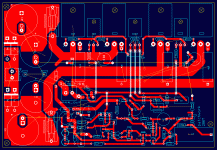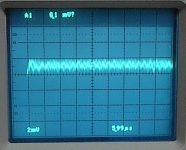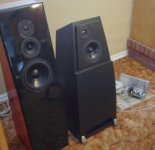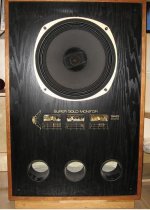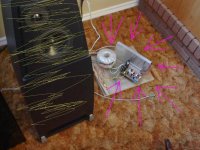MJL21193 said:
Copper top layer will be as before, with the single slot across the board.
Only single slot?
4fun said:
Only single slot?
Hi,
Yes, I'm keeping it as simple as possible. The one slot solution has proven itself to me. Amp is running and performance is exceptional. At idle, no signal there is no hum or hiss from the speaker - none at all.
I was trying to see this on the scope and I have a picture of that to show.
This is a measurement taken at the speaker output, with the speaker connected. Input to the amp is connected to a cheap CD player that is switch on, but not playing. Scope on it's lowest voltage setting (2mV) with the fine adjustment at maximum. Probe is a 10X.
The number at the top shows .1mV per division.
There isn't any noise problem.
Attachments
Ok, I respect that.
I'd just want to express my reason for the “single entry to ground” proposal as I expressed earlier and as I think PB2 also mentioned:
When high currents (read high current ripple harmonics) flow in the ground plane around smoothing caps etc they will spread wide over the ground plane and some small tiny amounts of voltage will eventually find its way over some parts of your small signal ground. With a small entry to the small signal ground there would not be such possibility.
I think that a high power distortion test at high frequencies would reveal some improvements, if not I take it all back.
This is maybe fine tuning from one with a language barrier to overcome, not easy to put the right expressions 🙂
I'd just want to express my reason for the “single entry to ground” proposal as I expressed earlier and as I think PB2 also mentioned:
When high currents (read high current ripple harmonics) flow in the ground plane around smoothing caps etc they will spread wide over the ground plane and some small tiny amounts of voltage will eventually find its way over some parts of your small signal ground. With a small entry to the small signal ground there would not be such possibility.
I think that a high power distortion test at high frequencies would reveal some improvements, if not I take it all back.
This is maybe fine tuning from one with a language barrier to overcome, not easy to put the right expressions 🙂
4fun said:Ok, I respect that.
I'd just want to express my reason for the “single entry to ground” proposal as I expressed earlier and as I think PB2 also mentioned:
When high currents (read high current ripple harmonics) flow in the ground plane around smoothing caps etc they will spread wide over the ground plane and some small tiny amounts of voltage will eventually find its way over some parts of your small signal ground. With a small entry to the small signal ground there would not be such possibility.
I think that a high power distortion test at high frequencies would reveal some improvements, if not I take it all back.
This is maybe fine tuning from one with a language barrier to overcome, not easy to put the right expressions 🙂
In an earth plane current will find the shortest path, it does not snake around the board. What John has done is perfectly good, he could get rid of the slot actually, it worsens the ground plane.
4fun said:
I think that a high power distortion test at high frequencies would reveal some improvements, if not I take it all back.
This is maybe fine tuning from one with a language barrier to overcome, not easy to put the right expressions 🙂
What language barrier?? Perfect English!
Everyone needs to be a little less sensitive, it's just an amp, not a woman!😉
The distortion you refer to should have shown up HERE , yes? Input to the amp was a 200mV squarewave. That translates into ~4 watts power into 4 ohm speaker. Not high power, but PRETTY LOUD!
I mainly wanted to avoid having slots cross power traces (or any other, for that matter).
Nico Ras said:
In an earth plane current will find the shortest path, it does not snake around the board. What John has done is perfectly good, he could get rid of the slot actually, it worsens the ground plane.
Hi nico,
Not a straight line of equal thickness path.
That slot improves the signal integrity of the small signal groundplane if connected properly to a common reference point where other ground plane(s) meet.
IMO, the key is no unnecessary currents injected in the small signal ground.
How the planes then are connected together is another issue however.
Hi John,
I have to much work in order to express myself in a way I can stand 🙂
If your amp works fine, all is fine.
4fun said:
Hi nico,
Not a straight line of equal thickness path.
That slot improves the signal integrity of the small signal groundplane if connected properly to a common reference point where other ground plane(s) meet.
IMO, the key is no unnecessary currents injected in the small signal ground.
How the planes then are connected together is another issue however.
Hi John,
I have to much work in order to express myself in a way I can stand 🙂
If your amp works fine, all is fine.
Yeah simple strip-line transmission theory, we all know that.

Nico Ras said:
Yeah simple strip-line transmission theory, we all know that.

Good.
4fun said:
If your amp works fine, all is fine.
Hi 4fun,
Like I said, your English is splendid!
I say the amp works fine. I have been trying to show some evidence of it's fidelity but I have limited equipment.
I thought the squarewave performance was impressive.
I have brought it up from my lab for a listening session on a superior speaker and a good quality source, in a comfortable setting.
It plays the right channel with the left being handled by my active 3-way. It is easily keeping up with the tri-amplified 3-way (no small feat - three LM3886's).
What can I say? It sounds good.
Krappy picture, I know.
Attachments
Hi,
John, keep up your good work.
I have seen better pics of your fine speakers in another thread. Nice to see 3-ways coming in fashion again.
I provide a pic of my current "office speakers", Tannoy SGM1000
(Ok, not home built)
To much speakers at home in order to make place for another "small" pair of Tannoy's 😀
John, keep up your good work.
I have seen better pics of your fine speakers in another thread. Nice to see 3-ways coming in fashion again.
I provide a pic of my current "office speakers", Tannoy SGM1000
(Ok, not home built)
To much speakers at home in order to make place for another "small" pair of Tannoy's 😀
Attachments
4fun said:Hi,
John, keep up your good work.
I have seen better pics of your fine speakers in another thread. Nice to see 3-ways coming in fashion again.
I provide a pic of my current "office speakers", Tannoy SGM1000
(Ok, not home built)
To much speakers at home in order to make place for another "small" pair of Tannoy's 😀
Hi John, thought I post my speaker too. I use a four way all KEFs. Amps are: 170 watt on bass, 120w on bass/mid; 50 w class A on low/mid and 30 watt class A on tweeter. X-over is 70Hz with EQ to produce flat response down to 11 Hz, then 70Hz - 350, 350 - 3500, 3500 up.
Attachments
4fun said:
I provide a pic of my current "office speakers", Tannoy SGM1000
(Ok, not home built)
To much speakers at home in order to make place for another "small" pair of Tannoy's 😀
Very nice. Looks like there are no screws holding the driver in??
Nico Ras said:
I use a four way all KEFs. Amps are: 170 watt on bass, 120w on bass/mid; 50 w class A on low/mid and 30 watt class A on tweeter.
Well done Nico! That's not enough power for one 4-way though.
 Gotta have a place to use all of those amps you build. 😎
Gotta have a place to use all of those amps you build. 😎I saw it somewhere else on this forum.
My picture wasn't so much about the speakers, but about my new creation!!
I am in AMP mode now, speaker mode was 4 months ago.🙂 🙂 😎
Attachments
MJL21193 said:
Very nice. Looks like there are no screws holding the driver in??
Well done Nico! That's not enough power for one 4-way though.
Gotta have a place to use all of those amps you build. 😎
I saw it somewhere else on this forum.
My picture wasn't so much about the speakers, but about my new creation!!
I am in AMP mode now, speaker mode was 4 months ago.🙂 🙂 😎
I know, I know. Just felt left behind for a moment, you getting so much attention!
You are absolutely right John. There was a time when power was fashionable and that is what I designed. I have been converted and are busy replacing the whole lot with low power single ended class A.
and that is what I designed. I have been converted and are busy replacing the whole lot with low power single ended class A. 
I did not remember just how good class A sounds. Besides since the amps will be "low" power (30 or so watt) simple and not that expensive.
"Normal" humans (excluding yourself as you say ) listen to 4 - 7 watt average, then 30 watt has ample headroom.
) listen to 4 - 7 watt average, then 30 watt has ample headroom.
I remember the days (there are quite a few of you out there that should) when hi-fi was defined as 10 watt and 1% THD.
(there are quite a few of you out there that should) when hi-fi was defined as 10 watt and 1% THD.
It was not necessarily stereo, that came later. Even that was loud in most cases.
Maybe humans have evolved and their ears are less sensitive, ambient noise levels skyrocketed or speaker designers just lost the nack for making efficient descent sounding speakers. I guess if there is enough power you can make anything to sound reasonable who cares if it is efficient.
I did, made speakers that is hardly 40 liters that produces a flat response from 10 Hz to 22kHz, who cares about the box, as long as it looks good, is small and keeps the speakers from lying on the floor.
In my office is another set of speakers, uses junk drivers, boxes are about 12 liters, electronically made them flat, also from 15 Hz to well over 20 kHz, they sound incredible too, but I don't tell anyone that I need a 210 watt amplifier to get the cones moving of its rest position.
I have a pre-1965 15 watt MacIntosh in the garage and a pair of battered old Klipsh that the veneer and joints pulled away, mice and other animals nest in them. They seen the best of about half a century. If turn the set up I can vibrate windows in the whole neighbourhood.
They seen the best of about half a century. If turn the set up I can vibrate windows in the whole neighbourhood. 
I can hardly vibrate my own windows with my current set, have to keep a fire extinguisher handy in case of a problem.
 and that is what I designed. I have been converted and are busy replacing the whole lot with low power single ended class A.
and that is what I designed. I have been converted and are busy replacing the whole lot with low power single ended class A. 
I did not remember just how good class A sounds. Besides since the amps will be "low" power (30 or so watt) simple and not that expensive.
"Normal" humans (excluding yourself as you say
 ) listen to 4 - 7 watt average, then 30 watt has ample headroom.
) listen to 4 - 7 watt average, then 30 watt has ample headroom.I remember the days
 (there are quite a few of you out there that should) when hi-fi was defined as 10 watt and 1% THD.
(there are quite a few of you out there that should) when hi-fi was defined as 10 watt and 1% THD. It was not necessarily stereo, that came later. Even that was loud in most cases.
Maybe humans have evolved and their ears are less sensitive, ambient noise levels skyrocketed or speaker designers just lost the nack for making efficient descent sounding speakers. I guess if there is enough power you can make anything to sound reasonable who cares if it is efficient.
I did, made speakers that is hardly 40 liters that produces a flat response from 10 Hz to 22kHz, who cares about the box, as long as it looks good, is small and keeps the speakers from lying on the floor.
In my office is another set of speakers, uses junk drivers, boxes are about 12 liters, electronically made them flat, also from 15 Hz to well over 20 kHz, they sound incredible too, but I don't tell anyone that I need a 210 watt amplifier to get the cones moving of its rest position.

I have a pre-1965 15 watt MacIntosh in the garage and a pair of battered old Klipsh that the veneer and joints pulled away, mice and other animals nest in them.
 They seen the best of about half a century. If turn the set up I can vibrate windows in the whole neighbourhood.
They seen the best of about half a century. If turn the set up I can vibrate windows in the whole neighbourhood. 
I can hardly vibrate my own windows with my current set, have to keep a fire extinguisher handy in case of a problem.

MJL21193 said:Very nice. Looks like there are no screws holding the driver in??
4 x M8 bolts.
Nico Ras said:or speaker designers just lost the nack for making efficient descent sounding speakers.
Say that again.
salas said:
Say that again.
Or speaker designers just lost the nack for making efficient descent sounding speakers.
You like that?
Nico Ras said:You are absolutely right John. There was a time when power was fashionableand that is what I designed. I have been converted and are busy replacing the whole lot with low power single ended class A.
In my office is another set of speakers, uses junk drivers, boxes are about 12 liters, electronically made them flat, also from 15 Hz to well over 20 kHz, they sound incredible too, but I don't tell anyone that I need a 210 watt amplifier to get the cones moving of its rest position.
Hello Nico,
I like to have more power than I need - always. Better to have too much than not enough.
This speaker I show above that my amp is driving is fairly low efficiency, about 88db. The crossover is complex, with many components. It needs a lot of power, as I like to listen LOUD, sometimes - REALLY loud.
For my active 3-ways, I would like to replace the LM3886 amps that drive the midrange and treble for low power class A amps. I think 30 watts for the mid and 20 for the tweeter.
Future project. 🙂
I am working on the board layout again. I have changed the VAS driver from a vertical position to horizontal, with the back facing up. It will be fastened through the board like the others.
Attachments
- Status
- Not open for further replies.
- Home
- Amplifiers
- Solid State
- Help with this amp? A patchwork product of simulation
